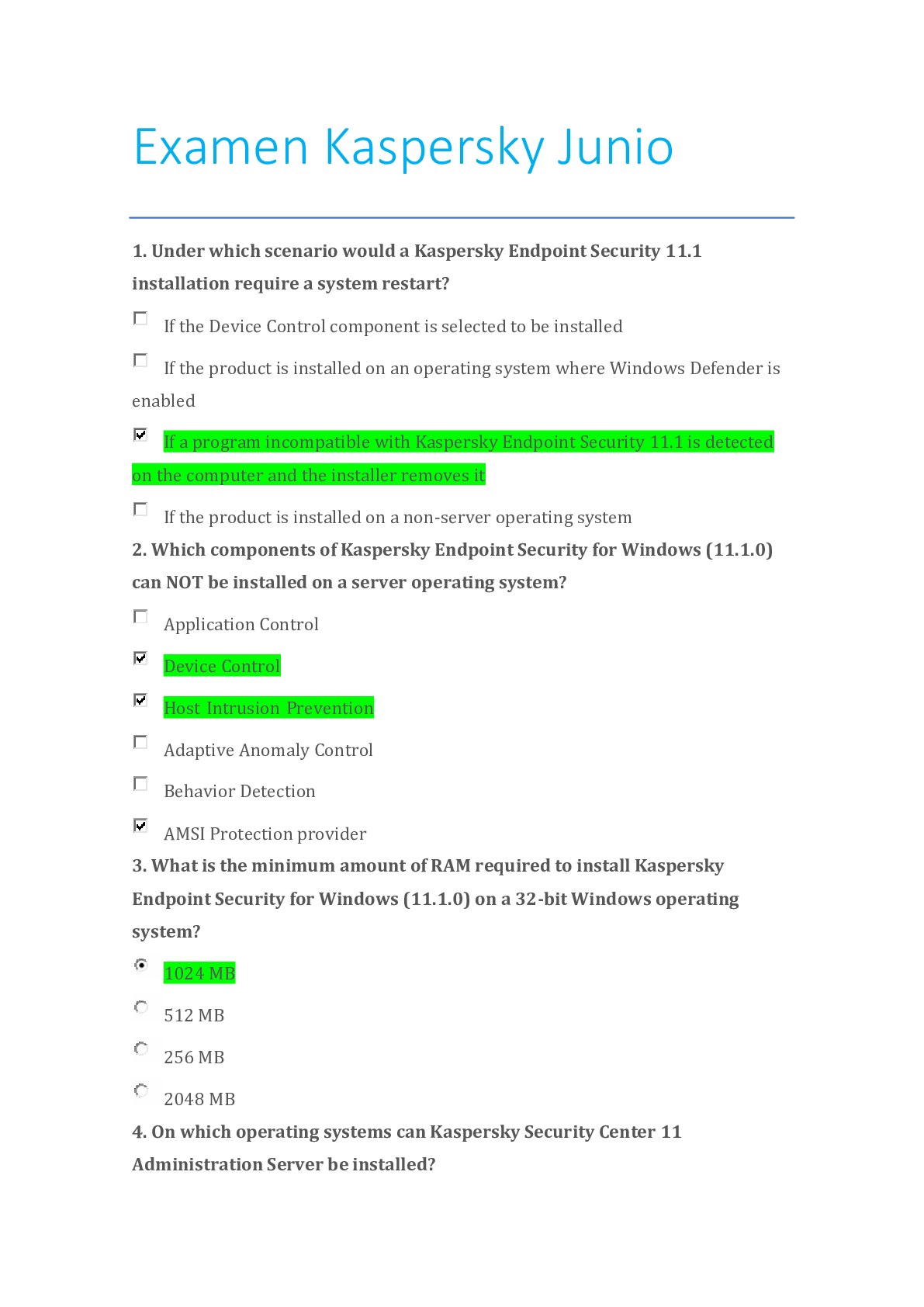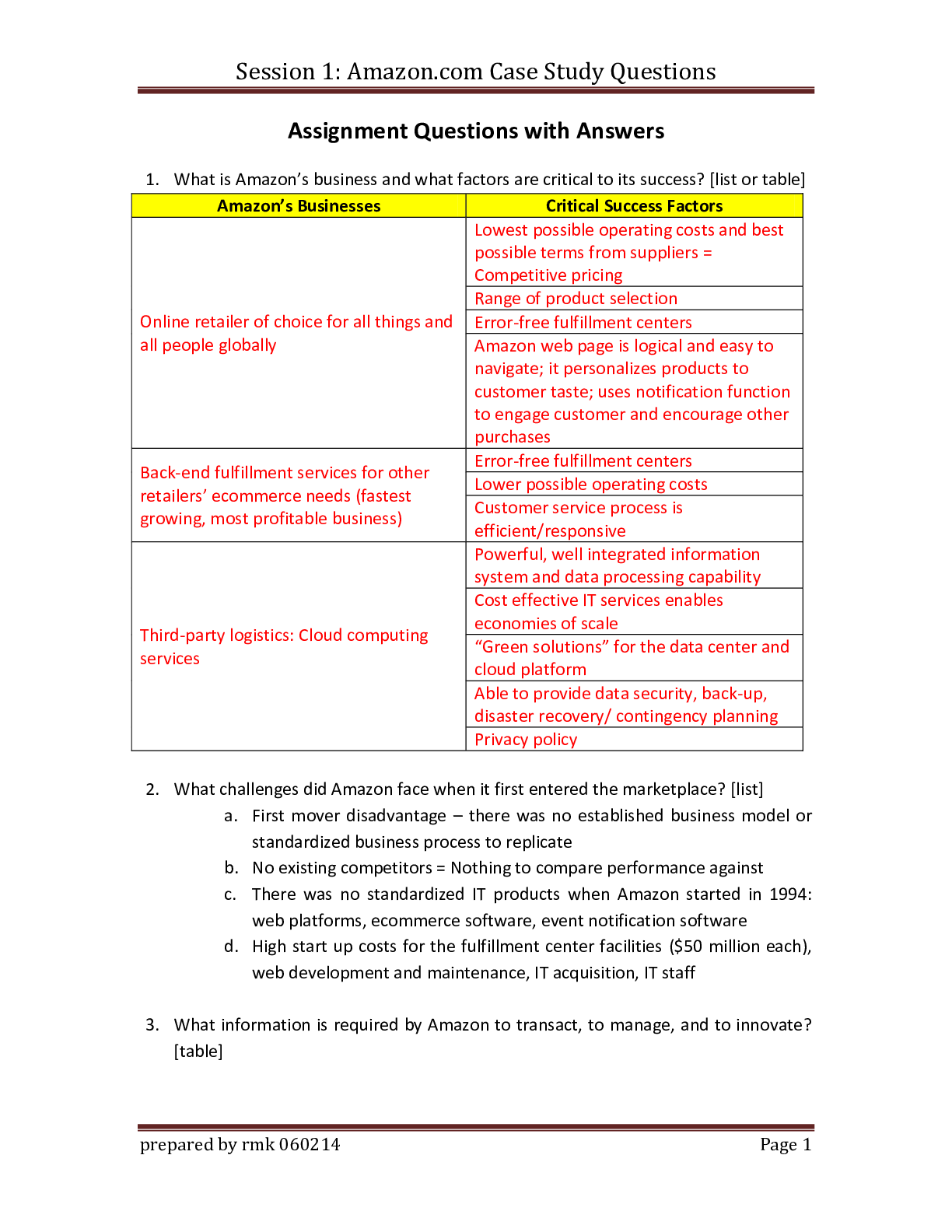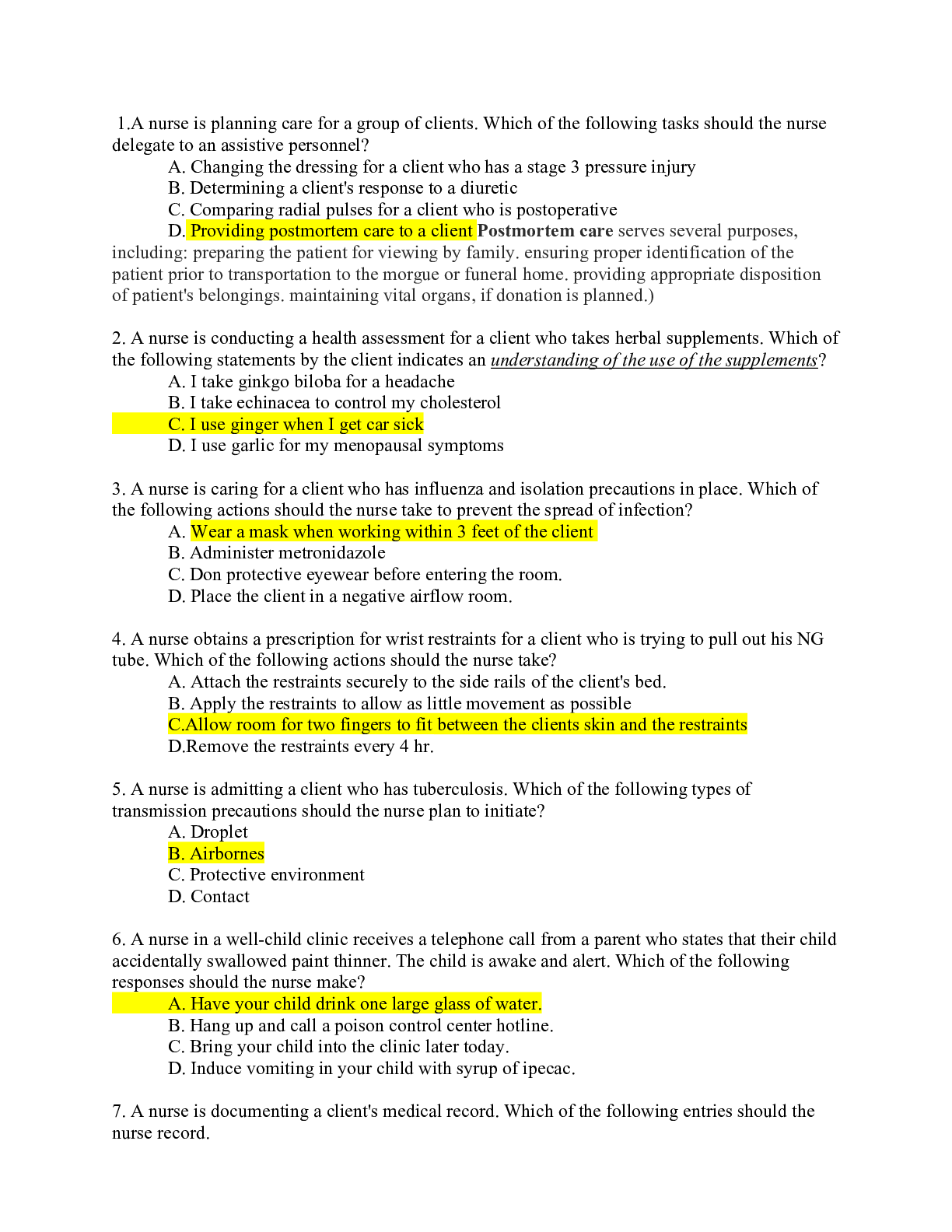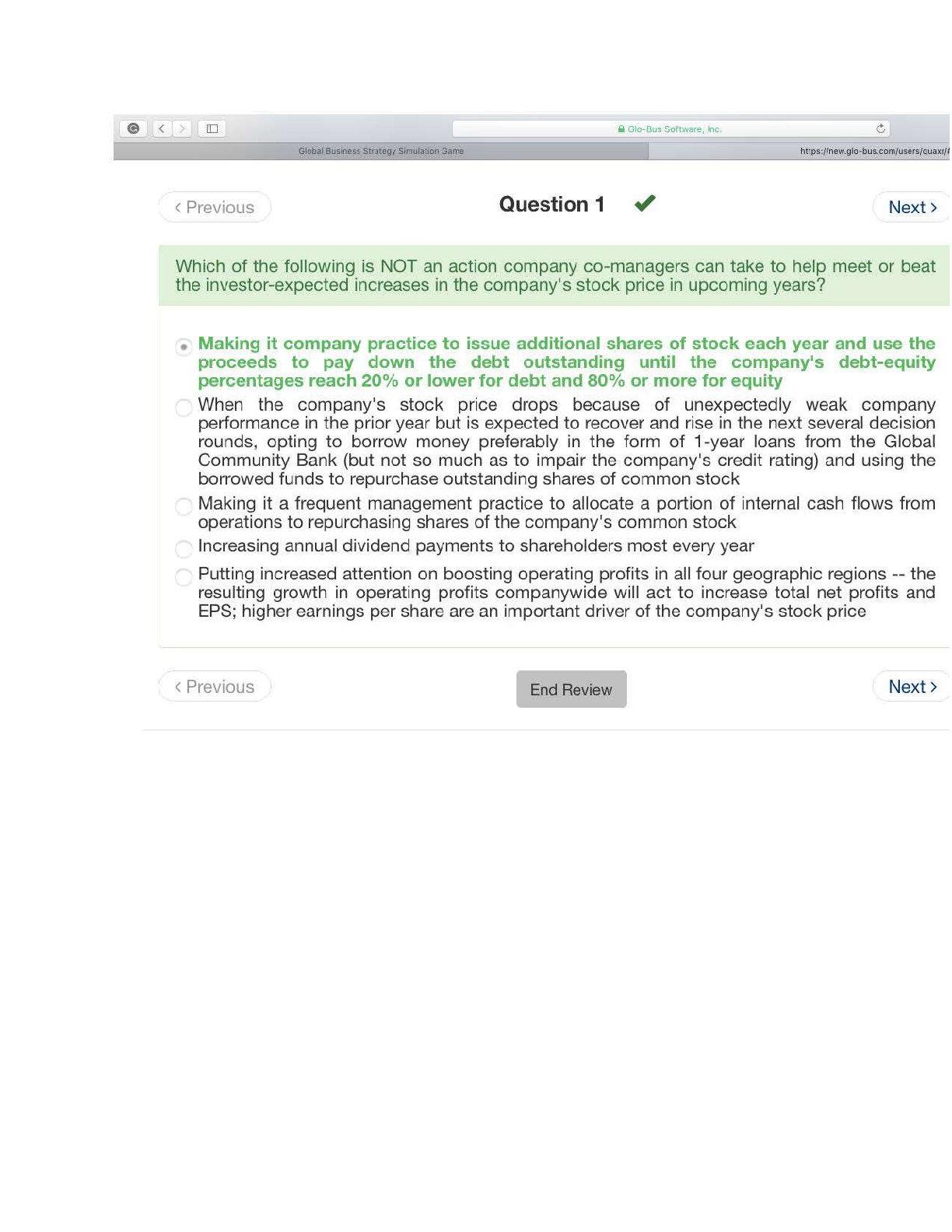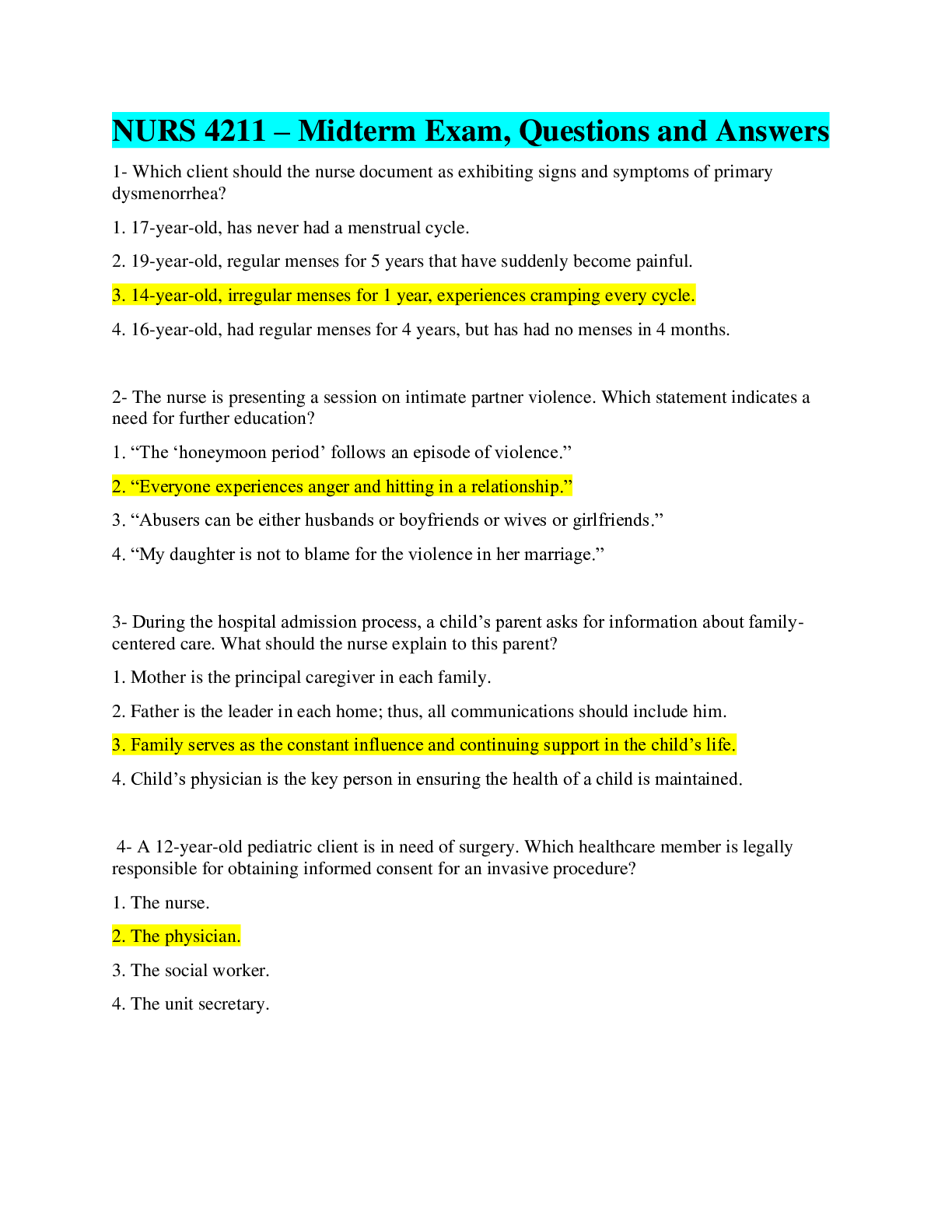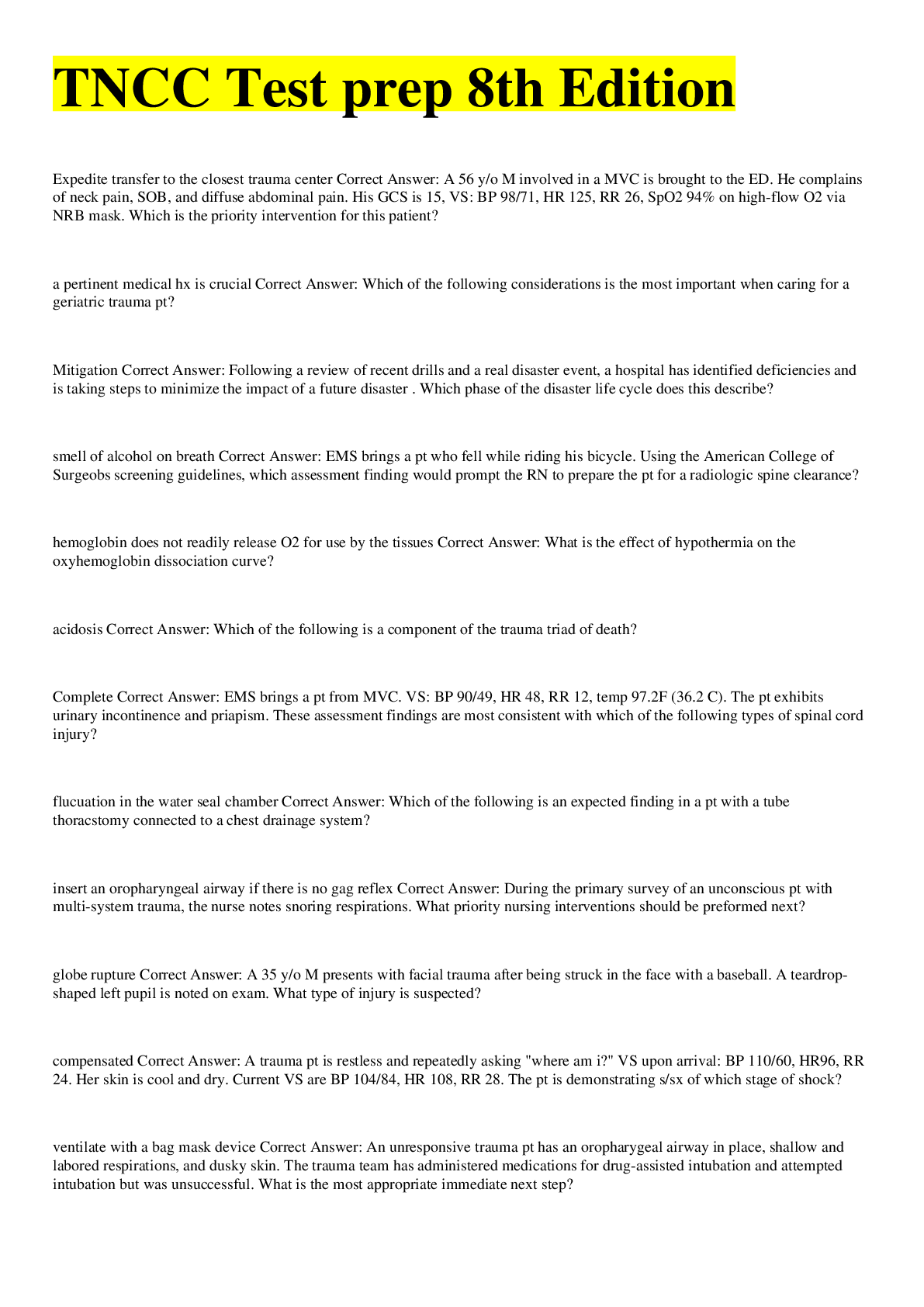*NURSING > QUESTIONS & ANSWERS > Miami Dade College, MiamiNUR 1234Lesson 07 - Perioperative Care _ NRSG2570_ Multisystem Disorders. 3 (All)
Miami Dade College, MiamiNUR 1234Lesson 07 - Perioperative Care _ NRSG2570_ Multisystem Disorders. 38 Questions and Answers. All Correct Answers Indicated.
Document Content and Description Below
Lesson 07 - Perioperative Care Due Apr 7 at 11:59pm Points 38 Questions 38 Available Mar 18 at 12am - Apr 7 at 11:59pm 21 days Time Limit None Attempt History. Question 1 Not yet graded / 1 pt... s Your Answer: Exercise 1 - Virtual Hospital Exercise This exercise will take approximately 45 minutes to complete. Sign in to work at Pacific View Regional Hospital for Period of Care 1. (Note: If you are already in the virtual hospital from a previous exercise, click on Leave the Floor and then Restart the Program to get to the sign-in window.) From the Patient List, select Piya Jordan (Room 403). Click on Go to Nurses’ Station. Click on Chart and then on 403. Click on Emergency Department and review the record. Exercise 1 - Question 1 What complaints (problems) brought Piya Jordan to the Emergency Department? Question 2 Not yet graded / 1 pts Your Answer: Exercise 1 - Question 2 What were her primary and secondary diagnoses on admission? 1. Nausea, vomiting 2. Obstruction Primary diagnosis: abdominal pain, nausea, vomiting, dehydration Secondary diagnosis: rule out (R/O) bowel obstruction, abdominal mass Question 3 0.75 / 1 pts Click on Nursing Admission. Click on History and Physical. Exercise 1 - Question 3 Which findings from the preoperative health history increase Piya Jordan's risk for surgical complications? Select all that apply. (Hint: See Table 14- Correct! Correct! Warfarin 5 mg daily Question 4 Not yet graded / 1 pts Your Answer: Now click on Laboratory Report. Exercise 1 - Question 4 Record Piya Jordan's CBC results from Monday at 2200. Insert an asterisk after any results that are abnormal. White blood cell count (WBC) Red blood cell count (RBC) Hemoglobin Platelets: 128* Question 5 Not yet graded / 1 pts Your Answer: Exercise 1 - Question 5 Record Piya Jordan's electrolyte results from Monday at 2200. Insert an asterisk after any results that are abnormal. Glucose Sodium Potassium GLUCOSE 98 SODIUM *147 POTASSIUM *3.3 Glucose: 98 Sodium: 147* Potassium: 3.3* Question 6 Not yet graded / 1 pts 4/7/2020 Lesson 07 - Perioperative Care : NRSG2570: Multisystem Disorders (1B-A_2020-02-24_Miramar) https://concorde.instructure.com/courses/27651/quizzes/132236 5/29 Your Answer: Exercise 1 - Question 6 Record Piya Jordan's renal results from Monday at 2200. Insert an asterisk after any results that are abnormal. Question 7 Not yet graded / 1 pts Your Answer: Exercise 1 - Question 7 Record Piya Jordan's urinalysis results from Monday at 2200. Insert an asterisk after any results that are abnormal. Urine glucose Blood Protein Leukocytes GLUCOSE Neg BLOOD Neg Question 8 Not yet graded / 1 pts Your Answer: Exercise 1 - Question 8 Record Piya Jordan's coagulation test results from Monday at 2200. Insert an asterisk after any results that are abnormal. Prothrombin time (PT) PT 19.8 INR 2.1 Prothrombin time (PT): 19.8* International normalized ratio (INR): 2.1* Question 9 Not yet graded / 1 pts Exercise 1 - Question 9 Record Piya Jordan's blood type results from Tuesday at 0630. 4/7/2020 Lesson 07 - Perioperative Care : NRSG2570: Multisystem Disorders (1B-A_2020-02-24_Miramar) https://concorde.instructure.com/courses/27651/quizzes/132236 7/29 Your Answer: A Pos Blood type: A+ Question 10 Not yet graded / 1 pts Your Answer: Exercise 1 - Question 10 Are any of Piya Jordan’s laboratory results abnormal or of concern for a patient preparing to undergo surgery? Explain. (Hint: See Chapter 14 in your textbook.) Question 11 0 / 1 pts Click on Surgical Reports. Exercise 1 - Question 11 Question 12 Not yet graded / 1 pts Your Answer: Exercise 1 - Question 12 Piya Jordan is 68 years of age. Her age increases her risk for the development of postoperative complications. For each body system below, list the age-related physiologic changes that increase her risks for complications and may delay her recovery. Then identify one to two nursing interventions that may be implemented to reduce complications. Cardiovascular system Respiratory system Renal system Neurologic system Integumentary system Cardiovascular system Physiologic change: Decreased cardiac output Increased blood pressure Reduced peripheral circulation Question 13 0.25 / 1 pts Exercise 1 - Question 13 When reviewing the medication list of a patient scheduled for surgery, which medication types are associated with an increased risk for complications? Select all that apply. Nonsteroidal antiinflammatory agents Anticoagulants Diuretics Antihypertensives Tricyclic antidepressants Question 14 Not yet graded / 1 pts Exercise 2 - Virtual Hospital Activity This exercise will take approximately 30 minutes to complete. Question 15 Not yet graded / 1 pts Your Answer: Exercise 2 - Question 2 Who is responsible for providing detailed information about the procedure(s) for which Piya Jordan has given consent? The surgeon The surgeon or physician Question 16 0.5 / 1 pts Exercise 2 - Question 3 Which are nursing responsibilities in regard to obtaining informed consent? Select all that apply. (Hint: See Chapter 14 in your textbook.) Clarify information presented by the physician Witness patient signature Question 17 Not yet graded / 1 pts Your Answer: Now click on Physician's Orders. Exercise 2 - Question 4 Look at the orders for Tuesday 0130. What consent was ordered? Yes Surgical consent for colectomy, possible colostomy Question 19 Not yet graded / 1 pts Your Answer: Exercise 2 - Question 6 What is the purpose of the mineral oil enema that was ordered to be given to Piya Jordan? It's a laxative, they are using it to clean out Piya's colon prior to her procedure. For bowel evacuation before major abdominal surgery; to prevent injury to colon and reduce number of intestinal bacteria Question 20 Not yet graded / 1 pts Exercise 2 - Question 7 Question 21 0 / 1 pts Answer 1: Answer 2: Exercise 2 - Question 8 The American Society of Anesthesiologists recommends an NPO time of at least 4-6 hours for easily digested solid foods and 2-3 hours for clear liquids before surgery. 4-6 6 2-3 2 Question 22 Not yet graded / 1 pts Your Answer: Exercise 2 - Question 9 What is the rationale for giving Piya Jordan a unit of fresh frozen plasma preoperatively? (Hint: See Chapter 40 in your textbook.) A unit of fresh frozen plasma (FFP) contains all coagulation factors. Piya is on Warfarin, so FFP is suggested in patients with life threatening or clinically significant bleeding; in Piya's cause it would be used for urgent preoperative warfarin reversal. Fresh frozen plasma (FFP) contains clotting factors, which will minimize bleeding risk in patient who has an elevated PT/INR before surgery. Question 23 Not yet graded / 1 pts Your Answer: Exercise 2 - Question 10 How long before surgery can an autologous blood transfusion be obtained? What is an advantage of this type of blood tranfusion? 1. All autologous blood donations/transfusion collection must be completed at least 3 days prior to surgery. 2. Autologous blood transfusion is the collection of blood from a single patient and retransfusion back to the same patient when required, because of this type of transfusion patients are assured that the blood is an exact match to her blood type, thereby avoiding transfusion reaction. Question 24 Not yet graded / 1 pts Your Answer: Exercise 2 - Question 11 What is the rationale for ordering a dose of cefotetan on call to the operating room for Piya Jordan? Is this a safe order to administer to her? Explain why or why not. (Hint: See Chapter 14 in your textbook.) Cefotetan disodium is a semisynthetic, beta-lactamase resistant, cephalosporin antibiotic that exerts its effect by inhibiting bacterial cell wall synthesis. It is considered a prophylactic. This is a safe dose, it is recommended at 1g or 2g. Cefotetan is a cephalosporin antibiotic given preoperatively to minimize the risk for infection during and after major surgery. It is not a safe order for Piya Jordan because she has a documented allergy to cephalosporins. Question 25 Not yet graded / 1 pts Click on Surgical Reports. Scroll down to the Preoperative Checklist. Exercise 2 - Question 12 Question 26 Not yet graded / 1 pts Exercise 3 - Virtual Hospital Activity This exercise will take approximately 45 minutes to complete. Clarence Hughes’ scheduled surgery has been completed. You will be reviewing the care already given to him and planning and evaluating care for him during the immediate postoperative period. Sign in to work at Pacific View Regional Hospital for Period of Care 1. (Note: If you are already in the virtual hospital from a previous exercise, click on Leave the Floor and then on Restart the Program to get to the sign-in window.) From the Patient List, select Clarence Hughes (Room 404). Question 27 Not yet graded / 1 pts Your Answer: Exercise 3 - Question 2 How frequently did the nurse assess Clarence Hughes’ vital signs after his arrival on the unit? How often do you think they should be assessed? (See Chapter 16 in your textbook.) Every 15-30 min. Question 28 Not yet graded / 1 pts Your Answer: Still in the EPR, select Intake and Output from the Category drop down menu. Exercise 3 - Question 3 Record Clarence Hughes’ intake and output for the past 3 days for the specified times. Sun 2300 Mon 0700 Mon 1500 Mon 2300 Tues 0700 Tues 1500 Tues 2300 Wed 0700 Mon 1500 1670 1750 Tues 0700 240 540 Tues 1500 1500 1050 Tues 2300 840 760 Wed 0700 240 420 Question 29 Not yet graded / 1 pts Exercise 3 - Question 4 Question 30 Not yet graded / 1 pts Your Answer: Exercise 3 - Question 5 What are the possible consequences if this trend in fluid balance continues? None. Fluid intake and output is balanced; patient should continue to recover without complications. Question 31 Not yet graded / 1 pts Click on Exit EPR. Click on Chart and then on 404. Click on Physician’s Orders. Question 32 1 / 1 pts Exercise 3 - Question 7 The physician prescribed enoxaparin. What is the purpose of this medication? Prevention of deep vein thrombosis Question 33 1 / 1 pts Exercise 3 - Question 8 When preparing to administer enoxaparin, the review of which laboratory test result is most important? Question 34 1 / 1 pts Exercise 3 - Question 9 When reviewing Clarence Hughes' health history, which finding, if noted, would be cause for concern with the administration of enoxaparin? Renal impairment Question 35 Not yet graded / 1 pts Your Answer: Exercise 3 - Question 10 What wound care is ordered on Sunday? 1. Wound drain--hemovac to compression suction. 2. Reinforce dressing to L knee as needed. Question 36 Not yet graded / 1 pts Your Answer: Exercise 3 - Question 11 Explain how and when to perform the ordered wound care. Add more material to the existing dressing; completed when the dressing becomes wet from drainage. Question 37 Not yet graded / 1 pts Your Answer: Click on Return to Nurses' Station and then on 404. Inside Clarence Hughes' room, click on Take Vital Signs. Review these results. Click on Clinical Alerts. Click on Patient Care and then on Nurse-Client Interactions. Select and view the video titled 0735: Empathy. (Note: Check the virtual clock to see whether enough time has elapsed. You can use the fast-forward feature to advance the time by 2-minute intervals if the video is not yet available. Then click again on Patient Care and then Nurse-Client Interactions to refresh the screen.) Exercise 3 - Question 12 What is Clarence Hughes’ major concern at this point? Question 38 Not yet graded / 1 pts Click on Medication Room. From the Medication Room, click on MAR to determine the medications that Clarence Hughes is ordered to receive at 0800 and any appropriate prn medications you may want to administer. (Note: You may click on Review MAR at any time to verify correct medication order. Click on the correct room number within the MAR. Remember to look at the patient name on the MAR to make sure you have the correct patient's record. Click on Return to Medication Room after reviewing the correct MAR.) Click on Unit Dosage. Click on drawer 404. From the list of available medications in the top window, select the medication(s) you would like to administer. After each medication you select, click on Put Medication on Tray. When you have finished putting your selected medications on the tray, click on Close Drawer. Click on View Medication Room. This time, click on Automated System. Your name and password will automatically appear. Click on Login. In box 1, select the correct patient; in box 2, choose the appropriate Automated System Drawer for this patent. Then click on Open Drawer. From the list of available medications, select the medication(s) you would like to administer. For each one selected, click on Put Medication on Tray. When you are finished, click on Close Drawer. Click on View Medication Room. From the Medication Room, click on Preparation and then highlight the medication you want to administer. Click on Prepare. Click on Next, choose the correct patient to administer this medication to, and click on Finish. Repeat the previous three steps until you have prepared all the medications you want to administer. You can click on Review Your Medications and then on Return to Medication Room when you are ready. Once you are back in the Medication Room, you may go directly to Clarence Hughes’ room by clicking on 404 at bottom of screen. Administer the medication, utilizing the six rights of medication administration. After you have collected the appropriate assessment data and are ready for administration, click on Patient Careand then on Medication Administration. Verify that the correct patient and medication(s) appear in the left-hand window. Then click the down arrow next to Select. From the drop-down menu, select Administer and complete the Administration Wizard by providing any information requested. When the Wizard stops asking for information, click on Administer to Patient. Specify Yes when asked whether this administration should be recorded in the MAR. Finally, click on Finish. Now, let's see how you did! Click on Leave the Floor at the bottom of your screen. From the Floor Menu, click on Look at Your Preceptor's Evaluation and then click on Medication Scorecard. Exercise 3 - Question 13 Note below whether or not you correctly administered the appropriate medication(s). If not, why do you think you were incorrect? According to Table C in this scorecard, what resources should be used and what important assessments should be completed before administering the medication(s)? Did you utilize these resources and perform these assessments correctly? [Show More]
Last updated: 1 year ago
Preview 1 out of 29 pages

Reviews( 0 )
Document information
Connected school, study & course
About the document
Uploaded On
May 14, 2021
Number of pages
29
Written in
Additional information
This document has been written for:
Uploaded
May 14, 2021
Downloads
0
Views
38

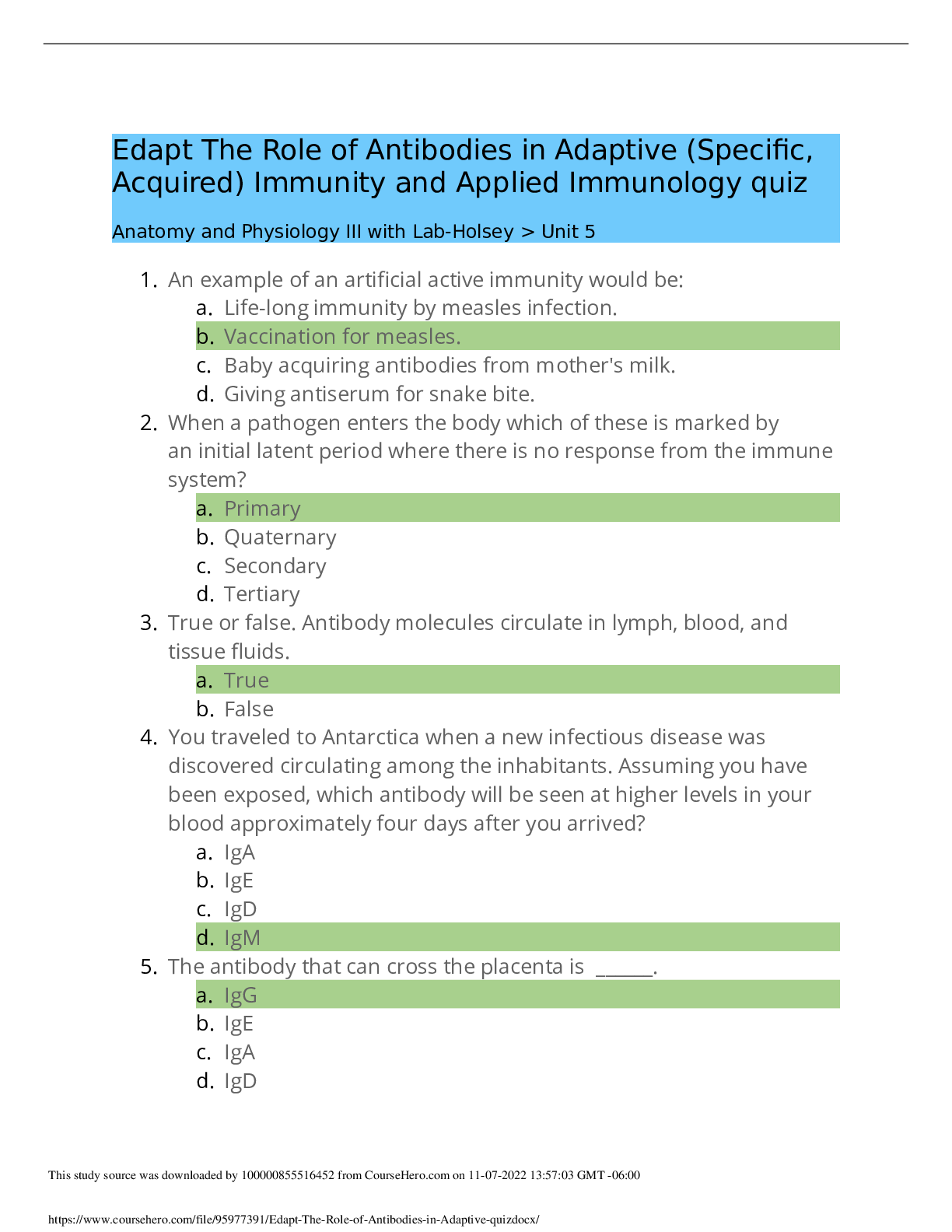
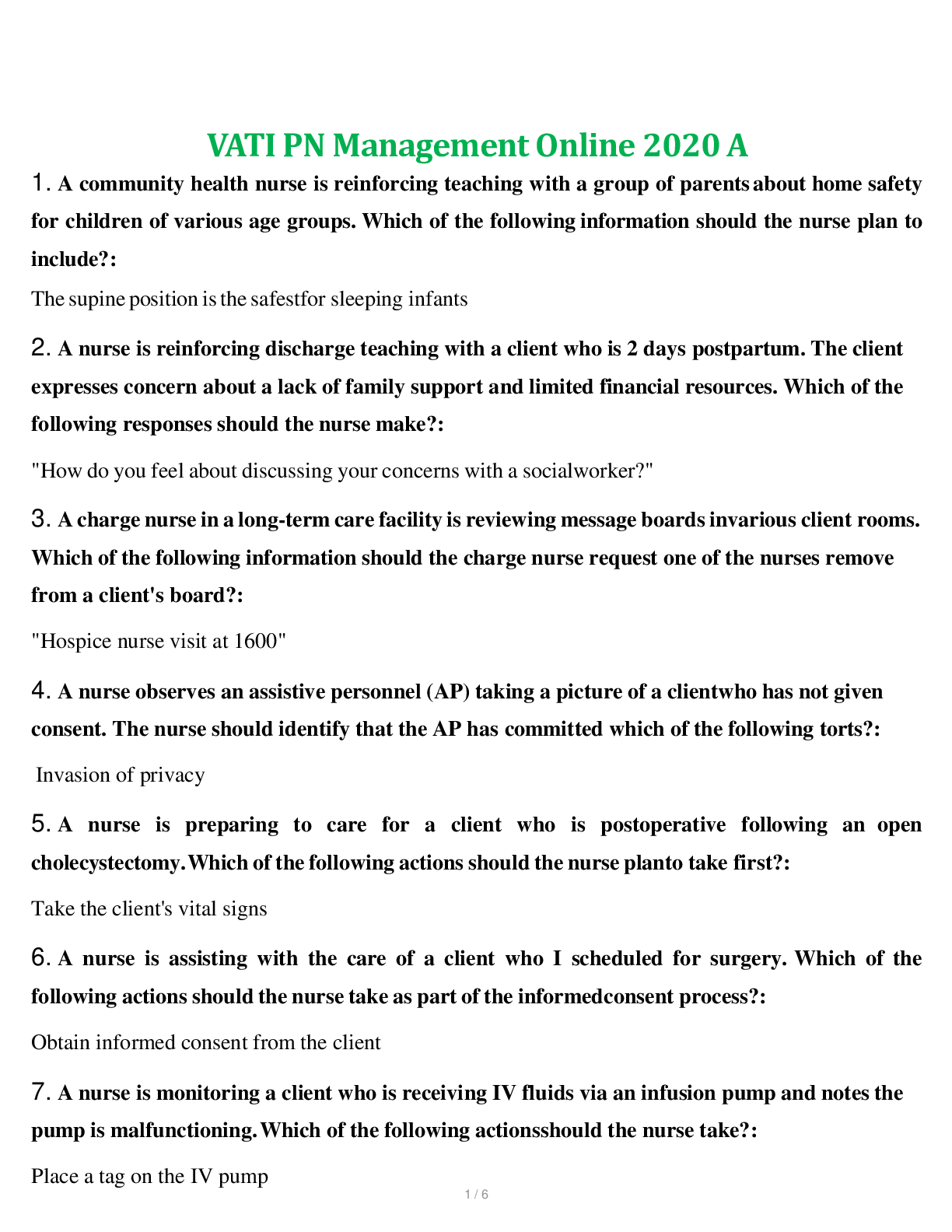


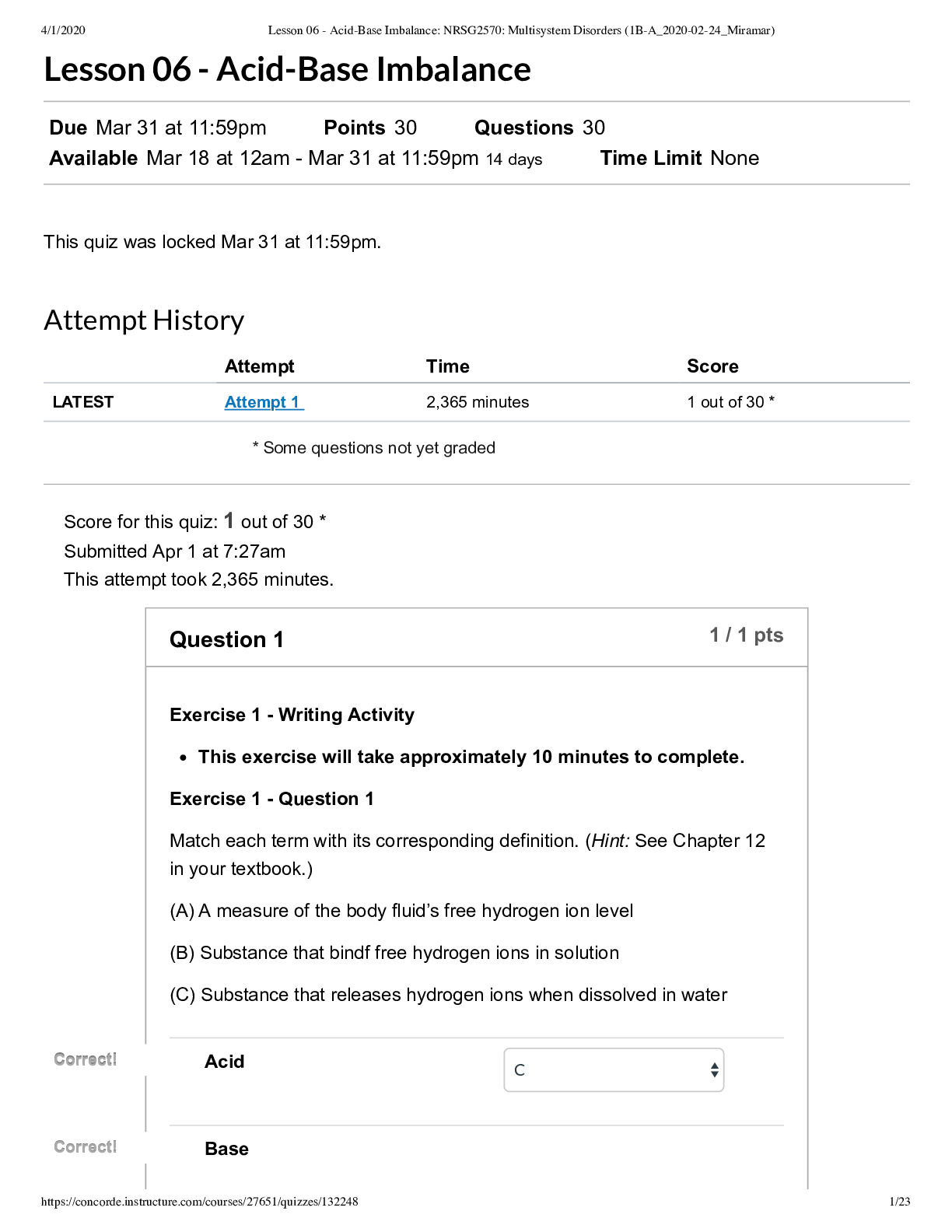


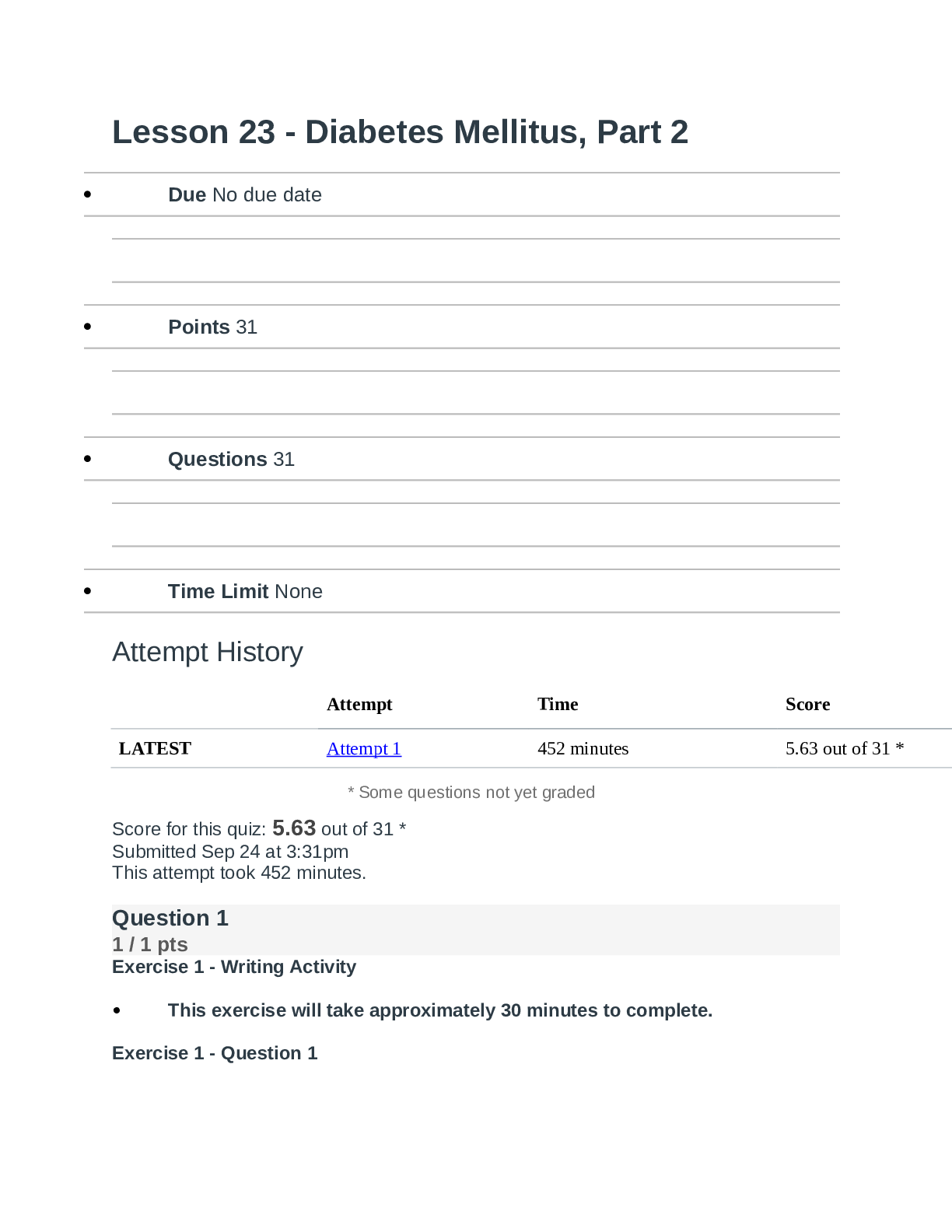

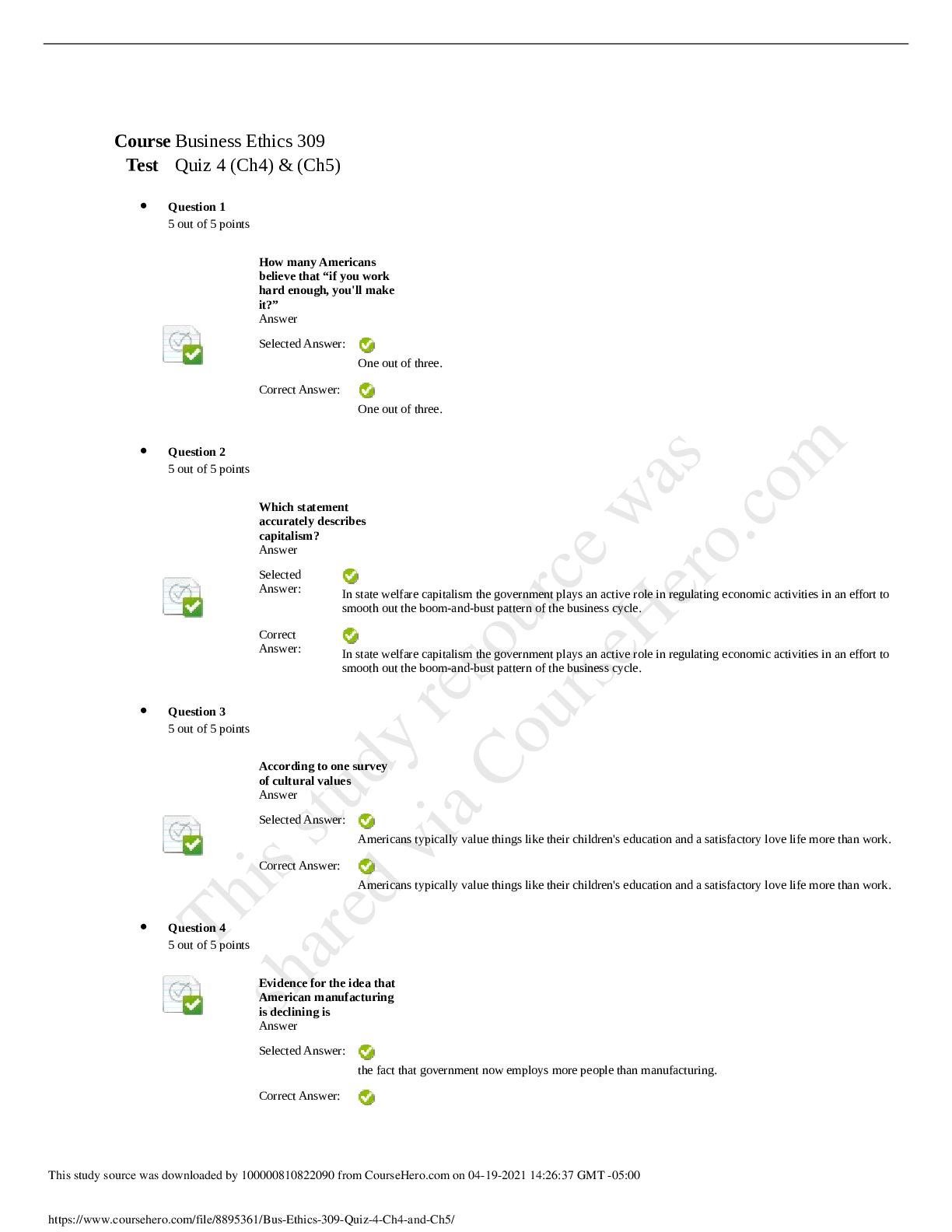








.png)

.png)



